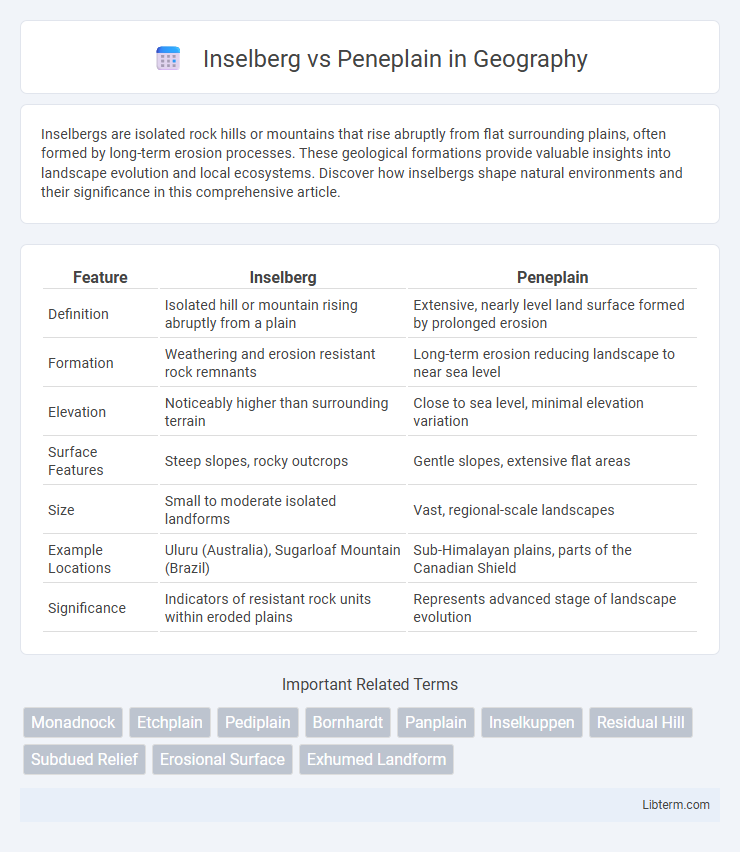Inselbergs are isolated rock hills or mountains that rise abruptly from flat surrounding plains, often formed by long-term erosion processes. These geological formations provide valuable insights into landscape evolution and local ecosystems. Discover how inselbergs shape natural environments and their significance in this comprehensive article.
Table of Comparison
| Feature | Inselberg | Peneplain |
|---|---|---|
| Definition | Isolated hill or mountain rising abruptly from a plain | Extensive, nearly level land surface formed by prolonged erosion |
| Formation | Weathering and erosion resistant rock remnants | Long-term erosion reducing landscape to near sea level |
| Elevation | Noticeably higher than surrounding terrain | Close to sea level, minimal elevation variation |
| Surface Features | Steep slopes, rocky outcrops | Gentle slopes, extensive flat areas |
| Size | Small to moderate isolated landforms | Vast, regional-scale landscapes |
| Example Locations | Uluru (Australia), Sugarloaf Mountain (Brazil) | Sub-Himalayan plains, parts of the Canadian Shield |
| Significance | Indicators of resistant rock units within eroded plains | Represents advanced stage of landscape evolution |
Definition of Inselberg
An inselberg is an isolated hill or mountain rising abruptly from a gently sloping or nearly level surrounding plain, formed by long-term erosion processes that leave resistant rock exposed. In contrast, a peneplain is an extensive, nearly flat land surface representing the final stage of fluvial erosion, characterized by minimal relief and widespread weathering. Inselbergs serve as prominent topographical features that stand distinct above the subdued terrain of peneplains.
Definition of Peneplain
A peneplain is an extensive, nearly level land surface formed by prolonged weathering and erosion, representing the final stage of landscape evolution before uplift. Inselbergs are isolated, steep-sided rocky hills rising abruptly from the peneplain, typically composed of resistant rock that withstands erosion. The distinction lies in the peneplain's broad, flat expanse compared to the pronounced elevation of inselbergs scattered upon it.
Geological Formation Processes
Inselbergs form through prolonged weathering and erosion of surrounding softer rock, leaving resistant rock masses standing as isolated hills. Peneplains develop over millions of years by extensive erosion that reduces terrain to near-flat surfaces close to base level. Inselbergs often emerge on peneplains as remnants of harder rock that resisted the flattening processes shaping the peneplain.
Morphological Characteristics
Inselbergs are isolated, steep-sided rock hills or mountains that rise abruptly from flat or gently sloping peneplains, representing resistant remnants of ancient landscapes. Peneplains are extensive, nearly level land surfaces formed by prolonged erosion and denote an advanced stage of landscape evolution with subdued relief. The morphological contrast is stark: inselbergs exhibit significant vertical relief and pronounced rock exposure, whereas peneplains display minimal elevation differences and extensive weathered cover.
Key Differences Between Inselbergs and Peneplains
Inselbergs are isolated, steep-sided rock hills or mountains rising abruptly from a gently sloping or nearly level surrounding plain, representing resistant rock remnants after extensive erosion. Peneplains are extensive, nearly level land surfaces formed by prolonged erosion and weathering, representing an advanced stage of landscape denudation. The key difference lies in their formation and morphology: inselbergs are prominent erosional remnants that stand out from the surrounding peneplain, which is a subdued and nearly flat erosion surface.
Global Examples of Inselbergs
Inselbergs, isolated steep rock hills rising abruptly from flat plains, are globally renowned with notable examples like Uluru in Australia, Sugarloaf Mountain in Brazil, and Ayers Rock in the Sahara Desert. These formations contrast sharply with peneplains, which represent nearly level land surfaces formed by long-term erosion and weathering processes. Inselbergs serve as prominent geological markers that highlight the difference between resistant rock outcrops and the surrounding eroded peneplain landscapes.
Notable Peneplains Around the World
Notable peneplains such as the African Surface in Southern Africa, the Canadian Shield peneplain, and the Scandinavian peneplain demonstrate extensive erosional processes that create vast, nearly flat landscapes contrasting with Inselbergs, which are isolated residual hills or mountains rising abruptly from these plains. The African Surface, dating back to the Late Mesozoic, reveals the prolonged denudation shaping much of Southern Africa, while the Canadian Shield peneplain illustrates ancient erosion over Precambrian rocks spanning millions of years. In Scandinavia, peneplains mark substantial tectonic stability and prolonged erosion, highlighting the geological significance of peneplains in understanding Earth's geomorphological evolution compared to the abrupt prominence of Inselbergs.
Environmental and Ecological Significance
Inselbergs, isolated rock hills rising sharply from flat plains, serve as critical refuges for unique flora and fauna, often harboring endemic species and providing microhabitats in arid or semi-arid environments. Peneplains, representing extensive, gently undulating landscapes formed by prolonged erosion, support diverse ecosystems by offering stable soils and hydrological conditions conducive to forests and grasslands. The contrast in topography between Inselbergs and peneplains creates heterogeneous habitats, enhancing regional biodiversity and influencing ecological processes such as water retention and nutrient cycling.
Role in Landscape Evolution
Inselbergs serve as prominent erosional remnants that highlight differential weathering and resist denudation, marking stages of landscape dissection in arid and semi-arid regions. Peneplains represent nearly level surfaces formed through prolonged erosion and uplift processes, indicating advanced stages of landscape evolution approaching base level equilibrium. The interplay between inselbergs and peneplains reveals the dynamic balance between tectonic uplift, weathering resistance, and erosion rates shaping long-term geomorphological development.
Human Interaction and Utilization
Inselbergs, isolated rocky hills rising abruptly from flat plains, often serve as natural landmarks and sites for cultural or religious activities, while their elevated terrain provides strategic advantages for observation and defense in human settlements. Peneplains, extensive nearly level land surfaces formed by prolonged erosion, support extensive agriculture and urban development due to their fertile soils and ease of construction. Human interaction with inselbergs tends to emphasize preservation and tourism, whereas peneplains are primarily utilized for large-scale farming, infrastructure, and habitation.
Inselberg Infographic

 libterm.com
libterm.com